Leadership and Culture: Analyzing Mahatma Gandhi's Leadership in India
VerifiedAdded on 2022/10/13
|11
|2034
|10
Report
AI Summary
This report examines the intersection of leadership and culture through the lens of Mahatma Gandhi's role in India's independence. It explores how Gandhi, a charismatic and transformational leader, utilized non-violent methods and cultural influence to mobilize the masses and achieve the country's freedom. The report highlights key historical events like the Champaran Satyagraha and the Non-Cooperation movement, illustrating Gandhi's leadership qualities, including his vision, commitment, and ability to inspire others. It also discusses the importance of cultural understanding and effective communication in achieving common goals. The analysis incorporates perspectives from various leadership theories and emphasizes the impact of Gandhi's actions on shaping India's identity and inspiring movements worldwide. The report concludes by emphasizing Gandhi's legacy as a leader who demonstrated the power of non-violent resistance and cultural sensitivity in achieving significant political and social change.
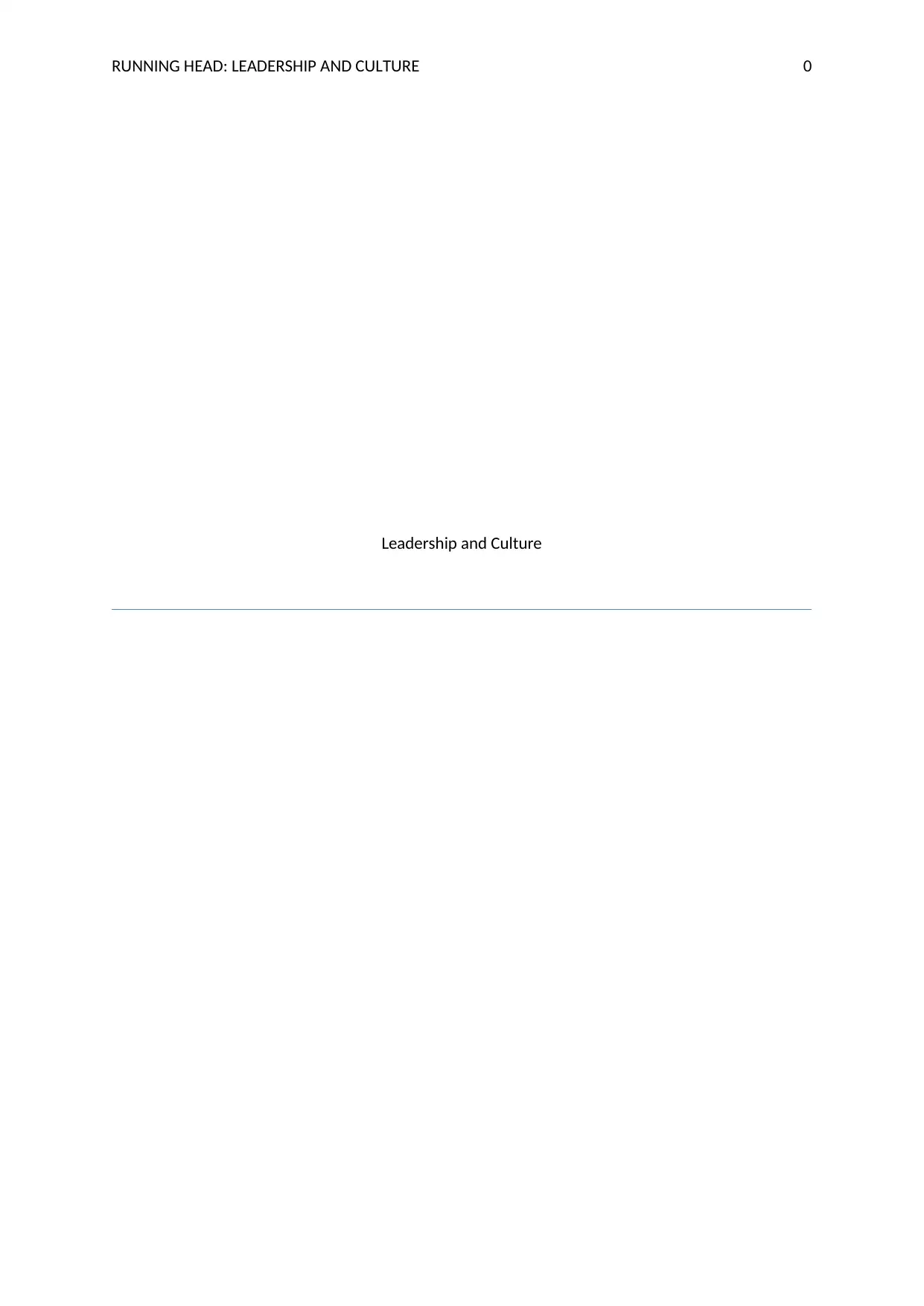
RUNNING HEAD: LEADERSHIP AND CULTURE 0
Leadership and Culture
Leadership and Culture
Paraphrase This Document
Need a fresh take? Get an instant paraphrase of this document with our AI Paraphraser
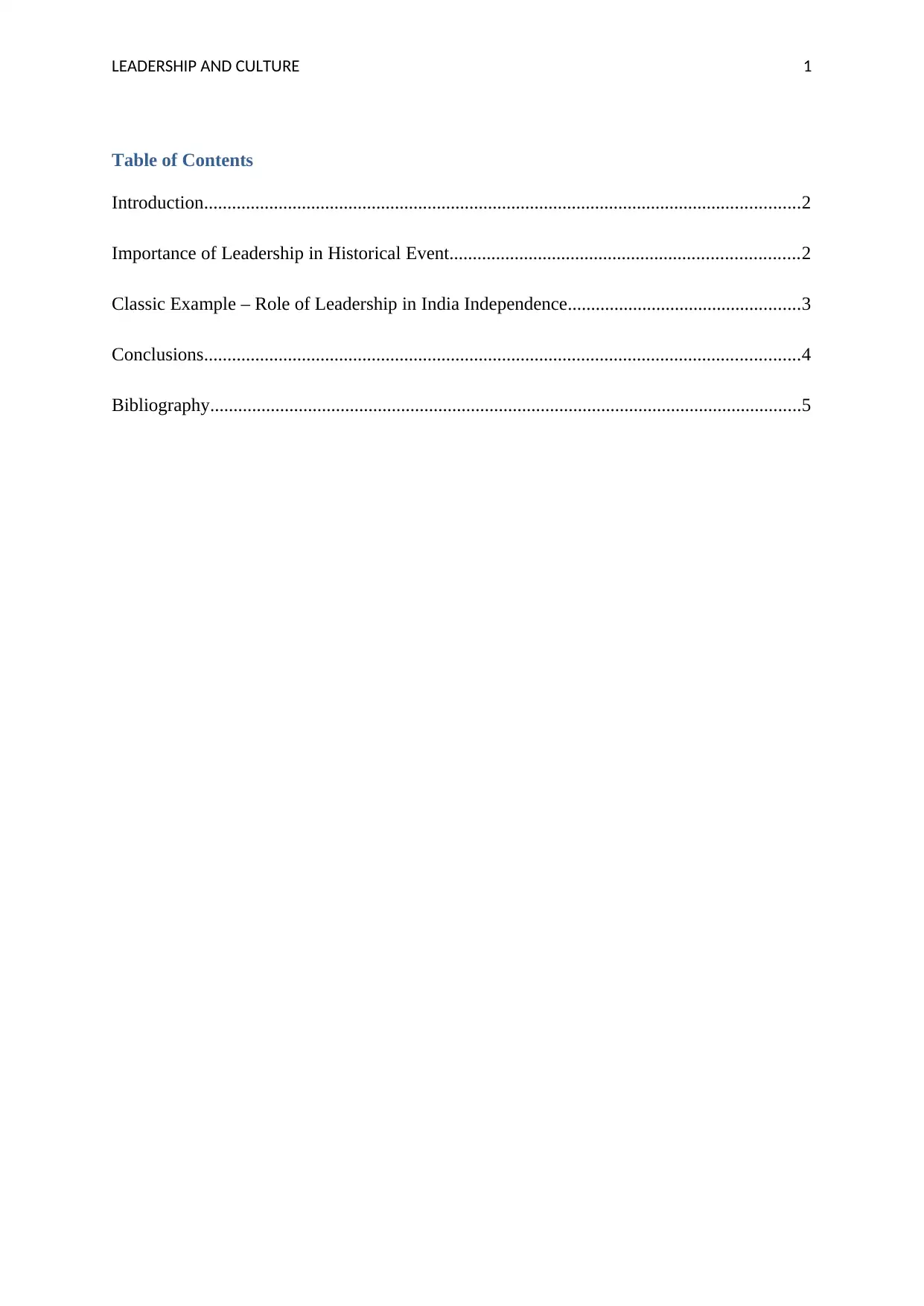
LEADERSHIP AND CULTURE 1
Table of Contents
Introduction................................................................................................................................2
Importance of Leadership in Historical Event...........................................................................2
Classic Example – Role of Leadership in India Independence..................................................3
Conclusions................................................................................................................................4
Bibliography...............................................................................................................................5
Table of Contents
Introduction................................................................................................................................2
Importance of Leadership in Historical Event...........................................................................2
Classic Example – Role of Leadership in India Independence..................................................3
Conclusions................................................................................................................................4
Bibliography...............................................................................................................................5
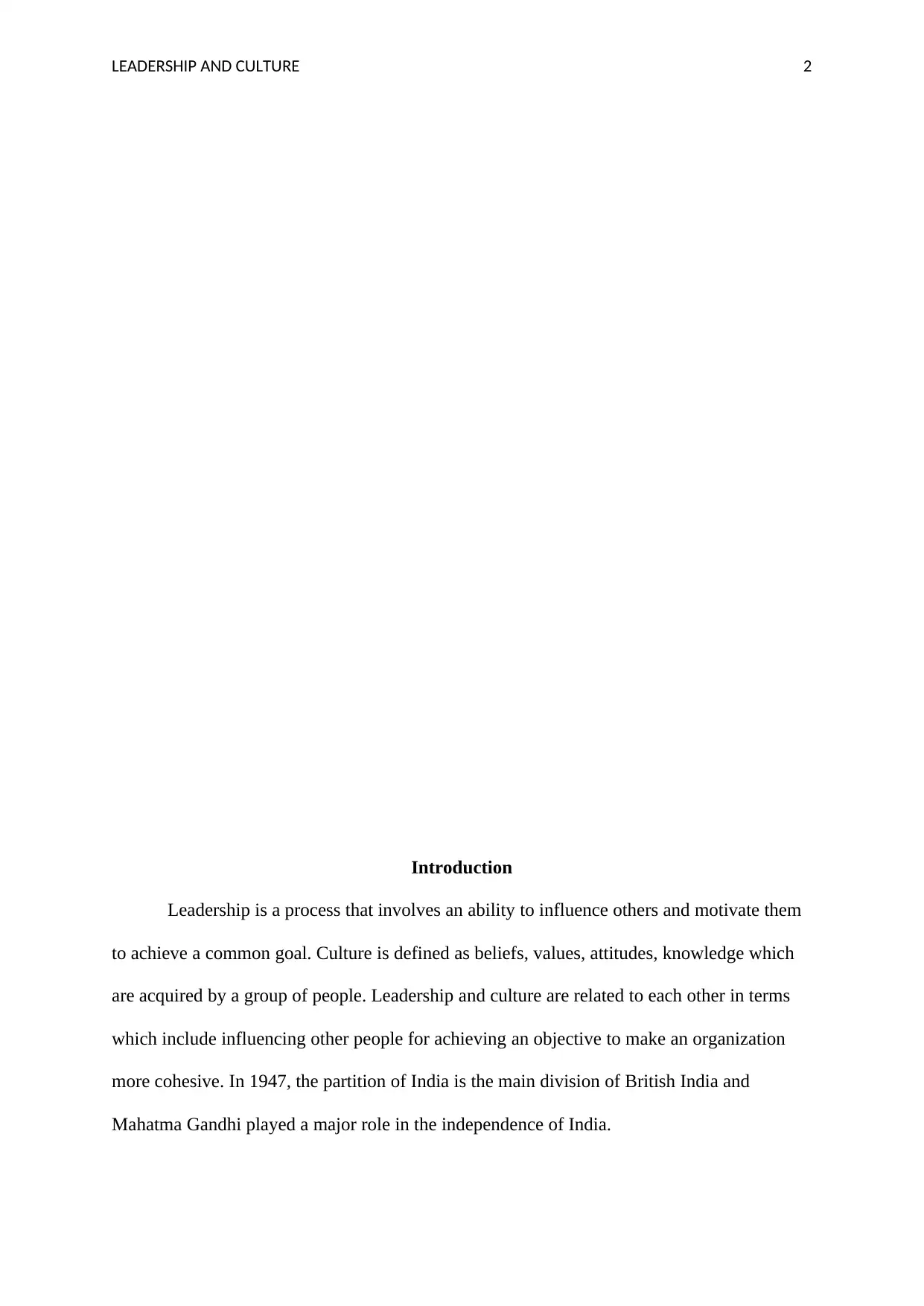
LEADERSHIP AND CULTURE 2
Introduction
Leadership is a process that involves an ability to influence others and motivate them
to achieve a common goal. Culture is defined as beliefs, values, attitudes, knowledge which
are acquired by a group of people. Leadership and culture are related to each other in terms
which include influencing other people for achieving an objective to make an organization
more cohesive. In 1947, the partition of India is the main division of British India and
Mahatma Gandhi played a major role in the independence of India.
Introduction
Leadership is a process that involves an ability to influence others and motivate them
to achieve a common goal. Culture is defined as beliefs, values, attitudes, knowledge which
are acquired by a group of people. Leadership and culture are related to each other in terms
which include influencing other people for achieving an objective to make an organization
more cohesive. In 1947, the partition of India is the main division of British India and
Mahatma Gandhi played a major role in the independence of India.
⊘ This is a preview!⊘
Do you want full access?
Subscribe today to unlock all pages.

Trusted by 1+ million students worldwide
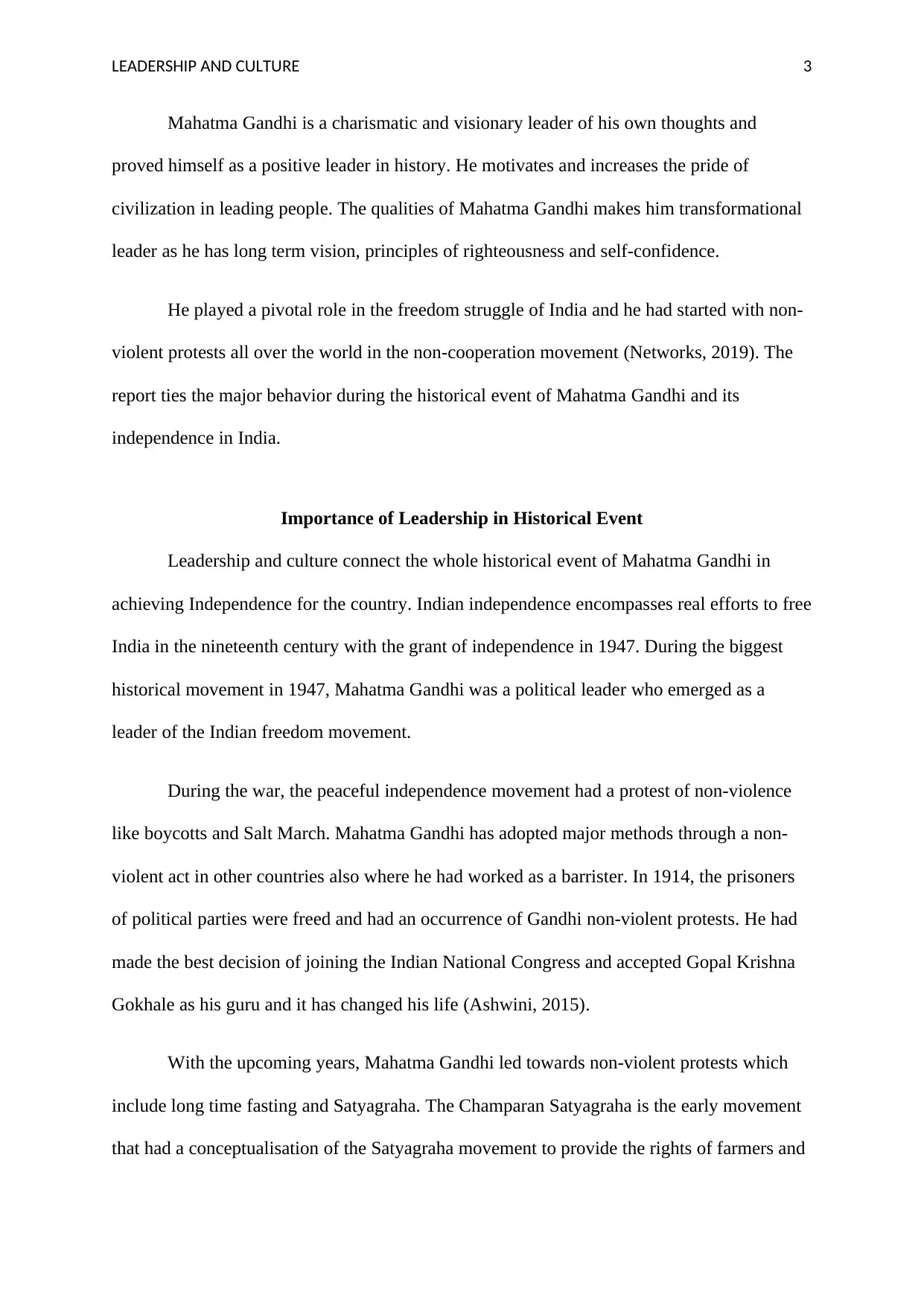
LEADERSHIP AND CULTURE 3
Mahatma Gandhi is a charismatic and visionary leader of his own thoughts and
proved himself as a positive leader in history. He motivates and increases the pride of
civilization in leading people. The qualities of Mahatma Gandhi makes him transformational
leader as he has long term vision, principles of righteousness and self-confidence.
He played a pivotal role in the freedom struggle of India and he had started with non-
violent protests all over the world in the non-cooperation movement (Networks, 2019). The
report ties the major behavior during the historical event of Mahatma Gandhi and its
independence in India.
Importance of Leadership in Historical Event
Leadership and culture connect the whole historical event of Mahatma Gandhi in
achieving Independence for the country. Indian independence encompasses real efforts to free
India in the nineteenth century with the grant of independence in 1947. During the biggest
historical movement in 1947, Mahatma Gandhi was a political leader who emerged as a
leader of the Indian freedom movement.
During the war, the peaceful independence movement had a protest of non-violence
like boycotts and Salt March. Mahatma Gandhi has adopted major methods through a non-
violent act in other countries also where he had worked as a barrister. In 1914, the prisoners
of political parties were freed and had an occurrence of Gandhi non-violent protests. He had
made the best decision of joining the Indian National Congress and accepted Gopal Krishna
Gokhale as his guru and it has changed his life (Ashwini, 2015).
With the upcoming years, Mahatma Gandhi led towards non-violent protests which
include long time fasting and Satyagraha. The Champaran Satyagraha is the early movement
that had a conceptualisation of the Satyagraha movement to provide the rights of farmers and
Mahatma Gandhi is a charismatic and visionary leader of his own thoughts and
proved himself as a positive leader in history. He motivates and increases the pride of
civilization in leading people. The qualities of Mahatma Gandhi makes him transformational
leader as he has long term vision, principles of righteousness and self-confidence.
He played a pivotal role in the freedom struggle of India and he had started with non-
violent protests all over the world in the non-cooperation movement (Networks, 2019). The
report ties the major behavior during the historical event of Mahatma Gandhi and its
independence in India.
Importance of Leadership in Historical Event
Leadership and culture connect the whole historical event of Mahatma Gandhi in
achieving Independence for the country. Indian independence encompasses real efforts to free
India in the nineteenth century with the grant of independence in 1947. During the biggest
historical movement in 1947, Mahatma Gandhi was a political leader who emerged as a
leader of the Indian freedom movement.
During the war, the peaceful independence movement had a protest of non-violence
like boycotts and Salt March. Mahatma Gandhi has adopted major methods through a non-
violent act in other countries also where he had worked as a barrister. In 1914, the prisoners
of political parties were freed and had an occurrence of Gandhi non-violent protests. He had
made the best decision of joining the Indian National Congress and accepted Gopal Krishna
Gokhale as his guru and it has changed his life (Ashwini, 2015).
With the upcoming years, Mahatma Gandhi led towards non-violent protests which
include long time fasting and Satyagraha. The Champaran Satyagraha is the early movement
that had a conceptualisation of the Satyagraha movement to provide the rights of farmers and
Paraphrase This Document
Need a fresh take? Get an instant paraphrase of this document with our AI Paraphraser
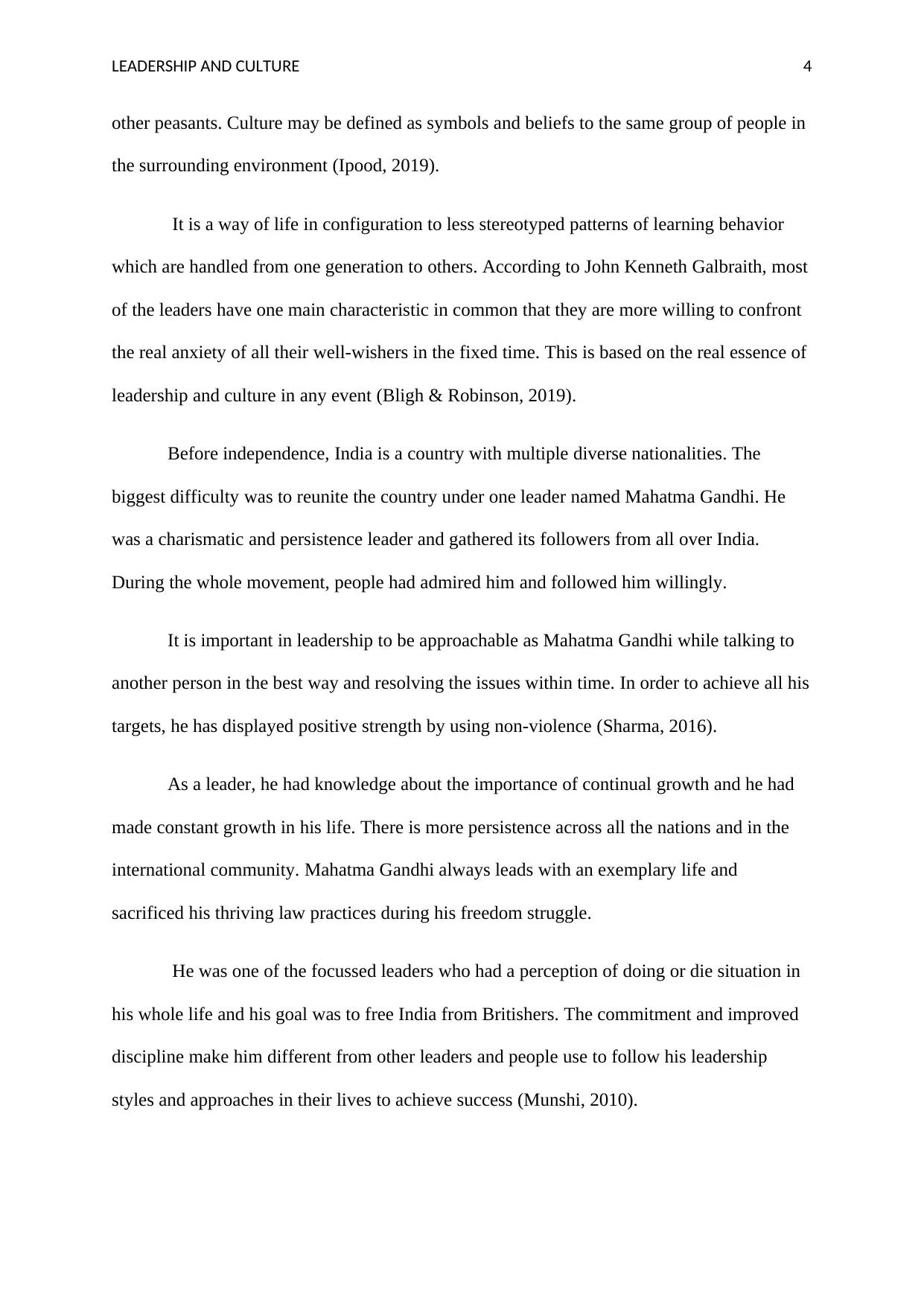
LEADERSHIP AND CULTURE 4
other peasants. Culture may be defined as symbols and beliefs to the same group of people in
the surrounding environment (Ipood, 2019).
It is a way of life in configuration to less stereotyped patterns of learning behavior
which are handled from one generation to others. According to John Kenneth Galbraith, most
of the leaders have one main characteristic in common that they are more willing to confront
the real anxiety of all their well-wishers in the fixed time. This is based on the real essence of
leadership and culture in any event (Bligh & Robinson, 2019).
Before independence, India is a country with multiple diverse nationalities. The
biggest difficulty was to reunite the country under one leader named Mahatma Gandhi. He
was a charismatic and persistence leader and gathered its followers from all over India.
During the whole movement, people had admired him and followed him willingly.
It is important in leadership to be approachable as Mahatma Gandhi while talking to
another person in the best way and resolving the issues within time. In order to achieve all his
targets, he has displayed positive strength by using non-violence (Sharma, 2016).
As a leader, he had knowledge about the importance of continual growth and he had
made constant growth in his life. There is more persistence across all the nations and in the
international community. Mahatma Gandhi always leads with an exemplary life and
sacrificed his thriving law practices during his freedom struggle.
He was one of the focussed leaders who had a perception of doing or die situation in
his whole life and his goal was to free India from Britishers. The commitment and improved
discipline make him different from other leaders and people use to follow his leadership
styles and approaches in their lives to achieve success (Munshi, 2010).
other peasants. Culture may be defined as symbols and beliefs to the same group of people in
the surrounding environment (Ipood, 2019).
It is a way of life in configuration to less stereotyped patterns of learning behavior
which are handled from one generation to others. According to John Kenneth Galbraith, most
of the leaders have one main characteristic in common that they are more willing to confront
the real anxiety of all their well-wishers in the fixed time. This is based on the real essence of
leadership and culture in any event (Bligh & Robinson, 2019).
Before independence, India is a country with multiple diverse nationalities. The
biggest difficulty was to reunite the country under one leader named Mahatma Gandhi. He
was a charismatic and persistence leader and gathered its followers from all over India.
During the whole movement, people had admired him and followed him willingly.
It is important in leadership to be approachable as Mahatma Gandhi while talking to
another person in the best way and resolving the issues within time. In order to achieve all his
targets, he has displayed positive strength by using non-violence (Sharma, 2016).
As a leader, he had knowledge about the importance of continual growth and he had
made constant growth in his life. There is more persistence across all the nations and in the
international community. Mahatma Gandhi always leads with an exemplary life and
sacrificed his thriving law practices during his freedom struggle.
He was one of the focussed leaders who had a perception of doing or die situation in
his whole life and his goal was to free India from Britishers. The commitment and improved
discipline make him different from other leaders and people use to follow his leadership
styles and approaches in their lives to achieve success (Munshi, 2010).
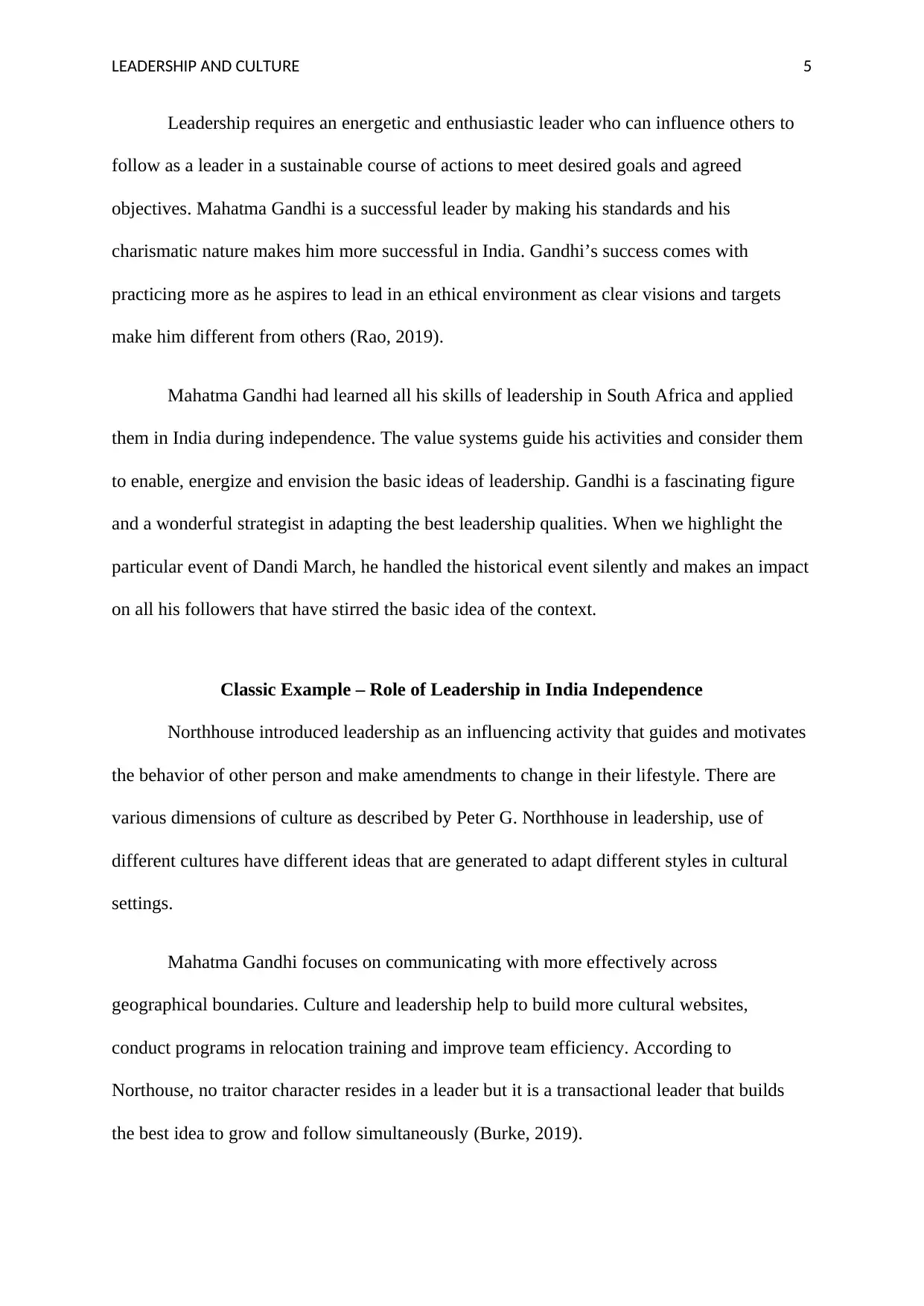
LEADERSHIP AND CULTURE 5
Leadership requires an energetic and enthusiastic leader who can influence others to
follow as a leader in a sustainable course of actions to meet desired goals and agreed
objectives. Mahatma Gandhi is a successful leader by making his standards and his
charismatic nature makes him more successful in India. Gandhi’s success comes with
practicing more as he aspires to lead in an ethical environment as clear visions and targets
make him different from others (Rao, 2019).
Mahatma Gandhi had learned all his skills of leadership in South Africa and applied
them in India during independence. The value systems guide his activities and consider them
to enable, energize and envision the basic ideas of leadership. Gandhi is a fascinating figure
and a wonderful strategist in adapting the best leadership qualities. When we highlight the
particular event of Dandi March, he handled the historical event silently and makes an impact
on all his followers that have stirred the basic idea of the context.
Classic Example – Role of Leadership in India Independence
Northhouse introduced leadership as an influencing activity that guides and motivates
the behavior of other person and make amendments to change in their lifestyle. There are
various dimensions of culture as described by Peter G. Northhouse in leadership, use of
different cultures have different ideas that are generated to adapt different styles in cultural
settings.
Mahatma Gandhi focuses on communicating with more effectively across
geographical boundaries. Culture and leadership help to build more cultural websites,
conduct programs in relocation training and improve team efficiency. According to
Northouse, no traitor character resides in a leader but it is a transactional leader that builds
the best idea to grow and follow simultaneously (Burke, 2019).
Leadership requires an energetic and enthusiastic leader who can influence others to
follow as a leader in a sustainable course of actions to meet desired goals and agreed
objectives. Mahatma Gandhi is a successful leader by making his standards and his
charismatic nature makes him more successful in India. Gandhi’s success comes with
practicing more as he aspires to lead in an ethical environment as clear visions and targets
make him different from others (Rao, 2019).
Mahatma Gandhi had learned all his skills of leadership in South Africa and applied
them in India during independence. The value systems guide his activities and consider them
to enable, energize and envision the basic ideas of leadership. Gandhi is a fascinating figure
and a wonderful strategist in adapting the best leadership qualities. When we highlight the
particular event of Dandi March, he handled the historical event silently and makes an impact
on all his followers that have stirred the basic idea of the context.
Classic Example – Role of Leadership in India Independence
Northhouse introduced leadership as an influencing activity that guides and motivates
the behavior of other person and make amendments to change in their lifestyle. There are
various dimensions of culture as described by Peter G. Northhouse in leadership, use of
different cultures have different ideas that are generated to adapt different styles in cultural
settings.
Mahatma Gandhi focuses on communicating with more effectively across
geographical boundaries. Culture and leadership help to build more cultural websites,
conduct programs in relocation training and improve team efficiency. According to
Northouse, no traitor character resides in a leader but it is a transactional leader that builds
the best idea to grow and follow simultaneously (Burke, 2019).
⊘ This is a preview!⊘
Do you want full access?
Subscribe today to unlock all pages.

Trusted by 1+ million students worldwide
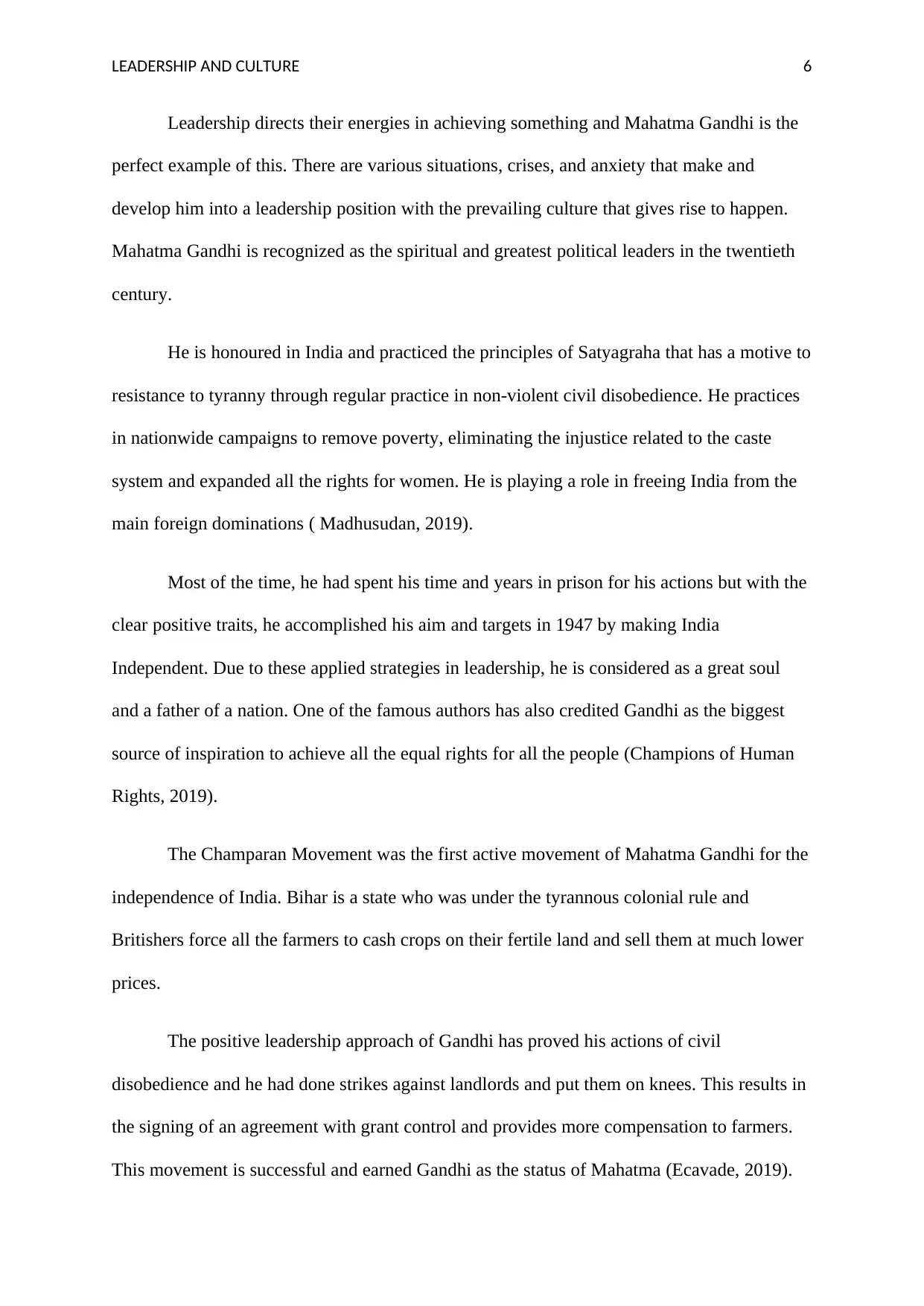
LEADERSHIP AND CULTURE 6
Leadership directs their energies in achieving something and Mahatma Gandhi is the
perfect example of this. There are various situations, crises, and anxiety that make and
develop him into a leadership position with the prevailing culture that gives rise to happen.
Mahatma Gandhi is recognized as the spiritual and greatest political leaders in the twentieth
century.
He is honoured in India and practiced the principles of Satyagraha that has a motive to
resistance to tyranny through regular practice in non-violent civil disobedience. He practices
in nationwide campaigns to remove poverty, eliminating the injustice related to the caste
system and expanded all the rights for women. He is playing a role in freeing India from the
main foreign dominations ( Madhusudan, 2019).
Most of the time, he had spent his time and years in prison for his actions but with the
clear positive traits, he accomplished his aim and targets in 1947 by making India
Independent. Due to these applied strategies in leadership, he is considered as a great soul
and a father of a nation. One of the famous authors has also credited Gandhi as the biggest
source of inspiration to achieve all the equal rights for all the people (Champions of Human
Rights, 2019).
The Champaran Movement was the first active movement of Mahatma Gandhi for the
independence of India. Bihar is a state who was under the tyrannous colonial rule and
Britishers force all the farmers to cash crops on their fertile land and sell them at much lower
prices.
The positive leadership approach of Gandhi has proved his actions of civil
disobedience and he had done strikes against landlords and put them on knees. This results in
the signing of an agreement with grant control and provides more compensation to farmers.
This movement is successful and earned Gandhi as the status of Mahatma (Ecavade, 2019).
Leadership directs their energies in achieving something and Mahatma Gandhi is the
perfect example of this. There are various situations, crises, and anxiety that make and
develop him into a leadership position with the prevailing culture that gives rise to happen.
Mahatma Gandhi is recognized as the spiritual and greatest political leaders in the twentieth
century.
He is honoured in India and practiced the principles of Satyagraha that has a motive to
resistance to tyranny through regular practice in non-violent civil disobedience. He practices
in nationwide campaigns to remove poverty, eliminating the injustice related to the caste
system and expanded all the rights for women. He is playing a role in freeing India from the
main foreign dominations ( Madhusudan, 2019).
Most of the time, he had spent his time and years in prison for his actions but with the
clear positive traits, he accomplished his aim and targets in 1947 by making India
Independent. Due to these applied strategies in leadership, he is considered as a great soul
and a father of a nation. One of the famous authors has also credited Gandhi as the biggest
source of inspiration to achieve all the equal rights for all the people (Champions of Human
Rights, 2019).
The Champaran Movement was the first active movement of Mahatma Gandhi for the
independence of India. Bihar is a state who was under the tyrannous colonial rule and
Britishers force all the farmers to cash crops on their fertile land and sell them at much lower
prices.
The positive leadership approach of Gandhi has proved his actions of civil
disobedience and he had done strikes against landlords and put them on knees. This results in
the signing of an agreement with grant control and provides more compensation to farmers.
This movement is successful and earned Gandhi as the status of Mahatma (Ecavade, 2019).
Paraphrase This Document
Need a fresh take? Get an instant paraphrase of this document with our AI Paraphraser
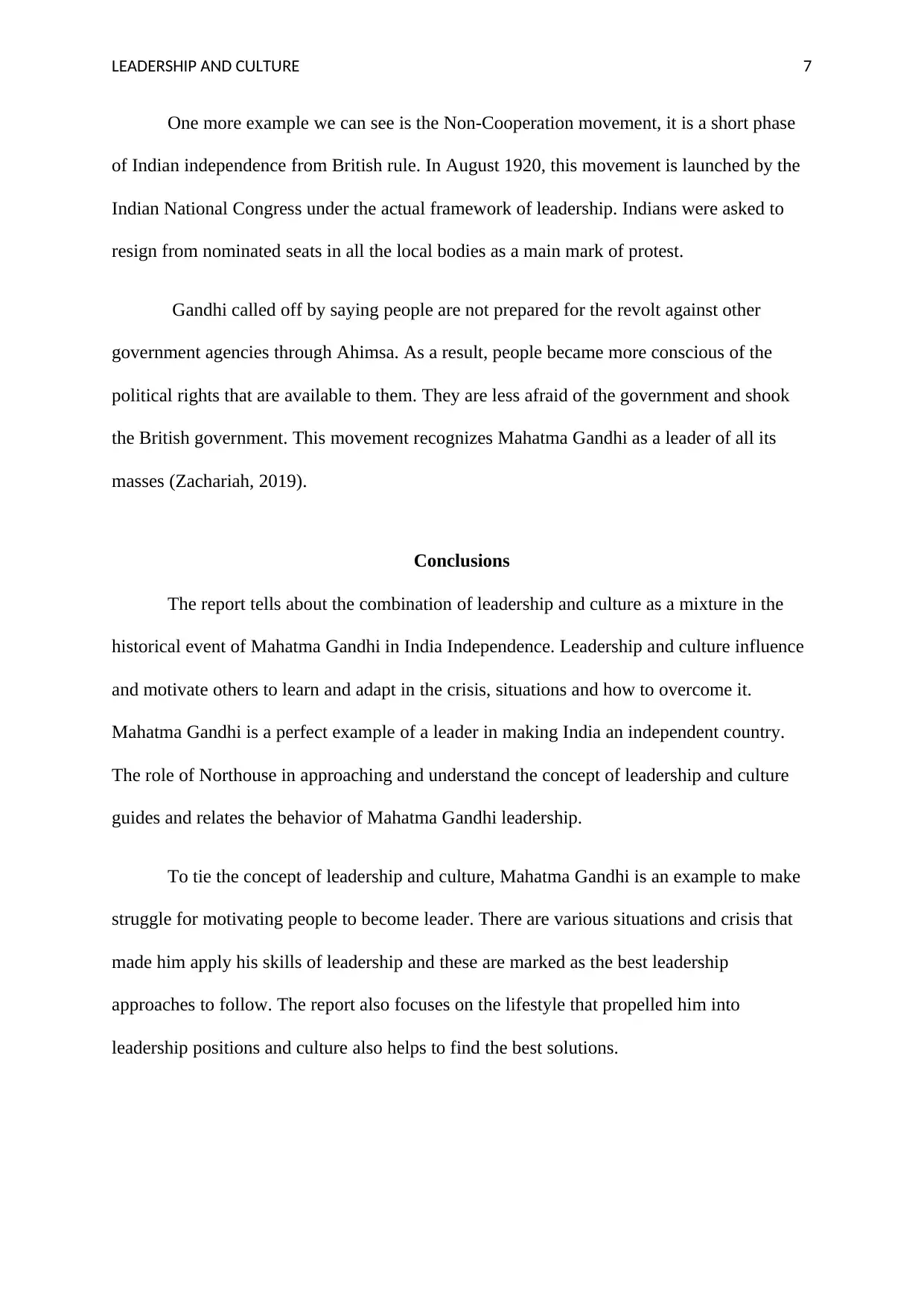
LEADERSHIP AND CULTURE 7
One more example we can see is the Non-Cooperation movement, it is a short phase
of Indian independence from British rule. In August 1920, this movement is launched by the
Indian National Congress under the actual framework of leadership. Indians were asked to
resign from nominated seats in all the local bodies as a main mark of protest.
Gandhi called off by saying people are not prepared for the revolt against other
government agencies through Ahimsa. As a result, people became more conscious of the
political rights that are available to them. They are less afraid of the government and shook
the British government. This movement recognizes Mahatma Gandhi as a leader of all its
masses (Zachariah, 2019).
Conclusions
The report tells about the combination of leadership and culture as a mixture in the
historical event of Mahatma Gandhi in India Independence. Leadership and culture influence
and motivate others to learn and adapt in the crisis, situations and how to overcome it.
Mahatma Gandhi is a perfect example of a leader in making India an independent country.
The role of Northouse in approaching and understand the concept of leadership and culture
guides and relates the behavior of Mahatma Gandhi leadership.
To tie the concept of leadership and culture, Mahatma Gandhi is an example to make
struggle for motivating people to become leader. There are various situations and crisis that
made him apply his skills of leadership and these are marked as the best leadership
approaches to follow. The report also focuses on the lifestyle that propelled him into
leadership positions and culture also helps to find the best solutions.
One more example we can see is the Non-Cooperation movement, it is a short phase
of Indian independence from British rule. In August 1920, this movement is launched by the
Indian National Congress under the actual framework of leadership. Indians were asked to
resign from nominated seats in all the local bodies as a main mark of protest.
Gandhi called off by saying people are not prepared for the revolt against other
government agencies through Ahimsa. As a result, people became more conscious of the
political rights that are available to them. They are less afraid of the government and shook
the British government. This movement recognizes Mahatma Gandhi as a leader of all its
masses (Zachariah, 2019).
Conclusions
The report tells about the combination of leadership and culture as a mixture in the
historical event of Mahatma Gandhi in India Independence. Leadership and culture influence
and motivate others to learn and adapt in the crisis, situations and how to overcome it.
Mahatma Gandhi is a perfect example of a leader in making India an independent country.
The role of Northouse in approaching and understand the concept of leadership and culture
guides and relates the behavior of Mahatma Gandhi leadership.
To tie the concept of leadership and culture, Mahatma Gandhi is an example to make
struggle for motivating people to become leader. There are various situations and crisis that
made him apply his skills of leadership and these are marked as the best leadership
approaches to follow. The report also focuses on the lifestyle that propelled him into
leadership positions and culture also helps to find the best solutions.
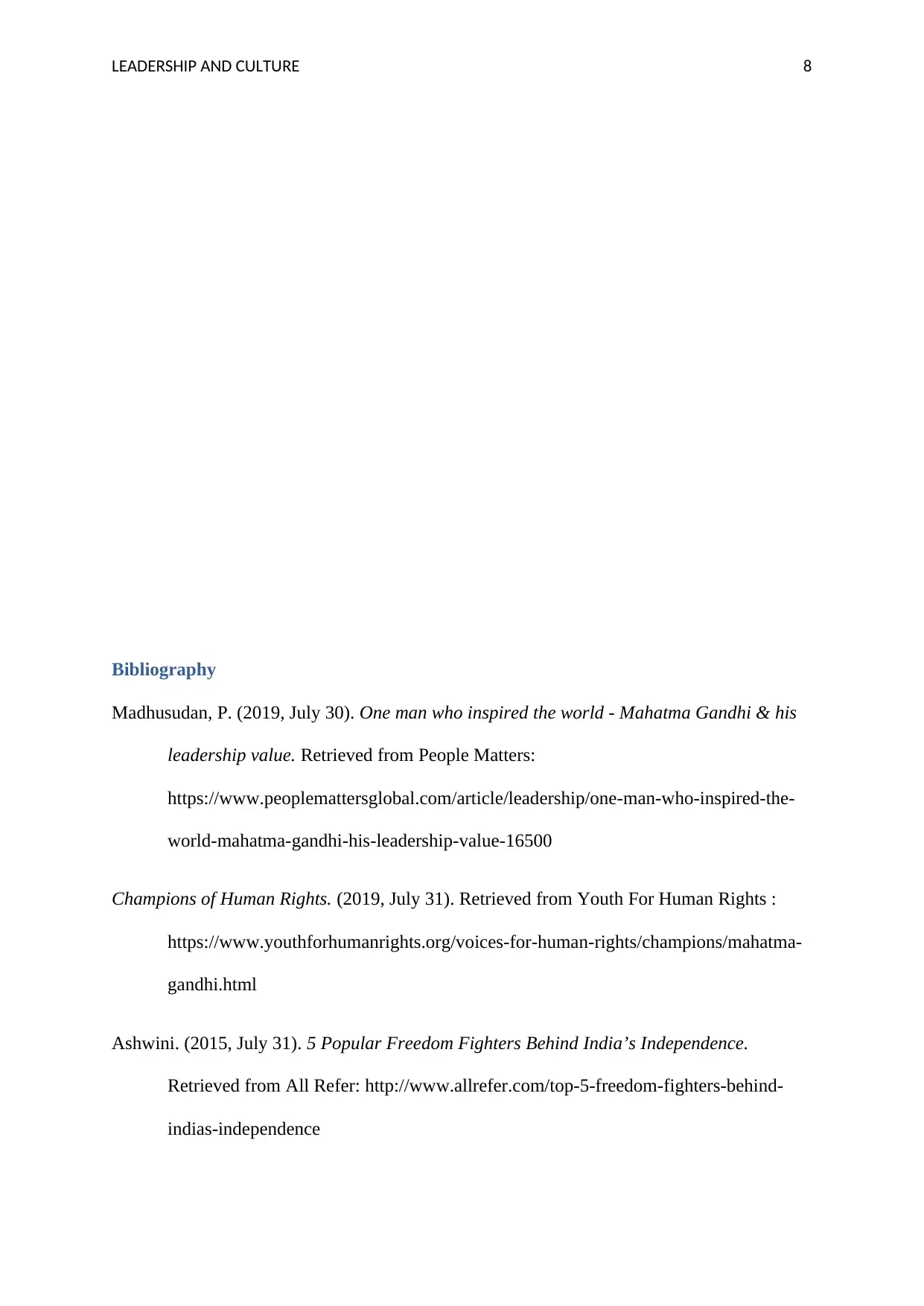
LEADERSHIP AND CULTURE 8
Bibliography
Madhusudan, P. (2019, July 30). One man who inspired the world - Mahatma Gandhi & his
leadership value. Retrieved from People Matters:
https://www.peoplemattersglobal.com/article/leadership/one-man-who-inspired-the-
world-mahatma-gandhi-his-leadership-value-16500
Champions of Human Rights. (2019, July 31). Retrieved from Youth For Human Rights :
https://www.youthforhumanrights.org/voices-for-human-rights/champions/mahatma-
gandhi.html
Ashwini. (2015, July 31). 5 Popular Freedom Fighters Behind India’s Independence.
Retrieved from All Refer: http://www.allrefer.com/top-5-freedom-fighters-behind-
indias-independence
Bibliography
Madhusudan, P. (2019, July 30). One man who inspired the world - Mahatma Gandhi & his
leadership value. Retrieved from People Matters:
https://www.peoplemattersglobal.com/article/leadership/one-man-who-inspired-the-
world-mahatma-gandhi-his-leadership-value-16500
Champions of Human Rights. (2019, July 31). Retrieved from Youth For Human Rights :
https://www.youthforhumanrights.org/voices-for-human-rights/champions/mahatma-
gandhi.html
Ashwini. (2015, July 31). 5 Popular Freedom Fighters Behind India’s Independence.
Retrieved from All Refer: http://www.allrefer.com/top-5-freedom-fighters-behind-
indias-independence
⊘ This is a preview!⊘
Do you want full access?
Subscribe today to unlock all pages.

Trusted by 1+ million students worldwide
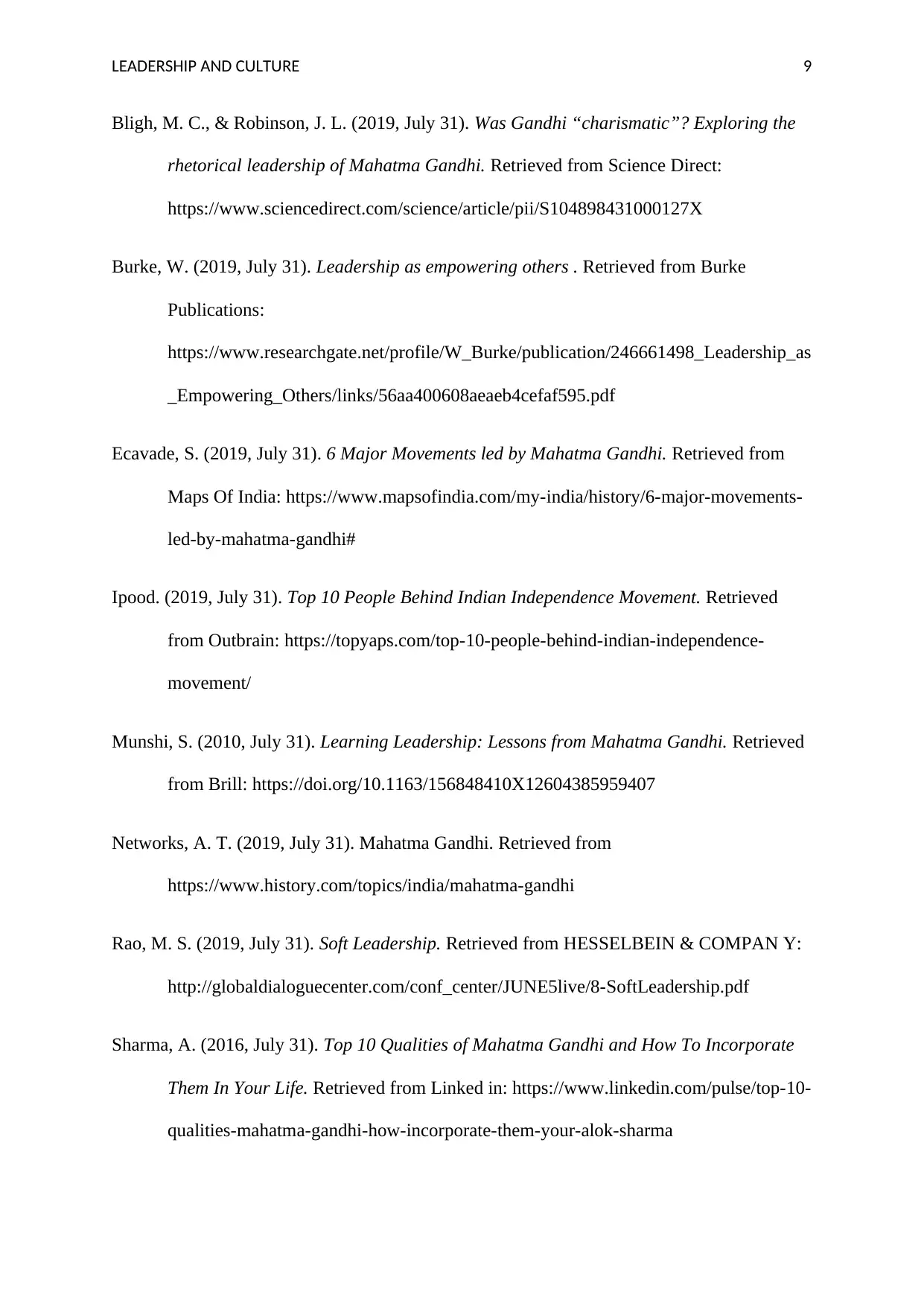
LEADERSHIP AND CULTURE 9
Bligh, M. C., & Robinson, J. L. (2019, July 31). Was Gandhi “charismatic”? Exploring the
rhetorical leadership of Mahatma Gandhi. Retrieved from Science Direct:
https://www.sciencedirect.com/science/article/pii/S104898431000127X
Burke, W. (2019, July 31). Leadership as empowering others . Retrieved from Burke
Publications:
https://www.researchgate.net/profile/W_Burke/publication/246661498_Leadership_as
_Empowering_Others/links/56aa400608aeaeb4cefaf595.pdf
Ecavade, S. (2019, July 31). 6 Major Movements led by Mahatma Gandhi. Retrieved from
Maps Of India: https://www.mapsofindia.com/my-india/history/6-major-movements-
led-by-mahatma-gandhi#
Ipood. (2019, July 31). Top 10 People Behind Indian Independence Movement. Retrieved
from Outbrain: https://topyaps.com/top-10-people-behind-indian-independence-
movement/
Munshi, S. (2010, July 31). Learning Leadership: Lessons from Mahatma Gandhi. Retrieved
from Brill: https://doi.org/10.1163/156848410X12604385959407
Networks, A. T. (2019, July 31). Mahatma Gandhi. Retrieved from
https://www.history.com/topics/india/mahatma-gandhi
Rao, M. S. (2019, July 31). Soft Leadership. Retrieved from HESSELBEIN & COMPAN Y:
http://globaldialoguecenter.com/conf_center/JUNE5live/8-SoftLeadership.pdf
Sharma, A. (2016, July 31). Top 10 Qualities of Mahatma Gandhi and How To Incorporate
Them In Your Life. Retrieved from Linked in: https://www.linkedin.com/pulse/top-10-
qualities-mahatma-gandhi-how-incorporate-them-your-alok-sharma
Bligh, M. C., & Robinson, J. L. (2019, July 31). Was Gandhi “charismatic”? Exploring the
rhetorical leadership of Mahatma Gandhi. Retrieved from Science Direct:
https://www.sciencedirect.com/science/article/pii/S104898431000127X
Burke, W. (2019, July 31). Leadership as empowering others . Retrieved from Burke
Publications:
https://www.researchgate.net/profile/W_Burke/publication/246661498_Leadership_as
_Empowering_Others/links/56aa400608aeaeb4cefaf595.pdf
Ecavade, S. (2019, July 31). 6 Major Movements led by Mahatma Gandhi. Retrieved from
Maps Of India: https://www.mapsofindia.com/my-india/history/6-major-movements-
led-by-mahatma-gandhi#
Ipood. (2019, July 31). Top 10 People Behind Indian Independence Movement. Retrieved
from Outbrain: https://topyaps.com/top-10-people-behind-indian-independence-
movement/
Munshi, S. (2010, July 31). Learning Leadership: Lessons from Mahatma Gandhi. Retrieved
from Brill: https://doi.org/10.1163/156848410X12604385959407
Networks, A. T. (2019, July 31). Mahatma Gandhi. Retrieved from
https://www.history.com/topics/india/mahatma-gandhi
Rao, M. S. (2019, July 31). Soft Leadership. Retrieved from HESSELBEIN & COMPAN Y:
http://globaldialoguecenter.com/conf_center/JUNE5live/8-SoftLeadership.pdf
Sharma, A. (2016, July 31). Top 10 Qualities of Mahatma Gandhi and How To Incorporate
Them In Your Life. Retrieved from Linked in: https://www.linkedin.com/pulse/top-10-
qualities-mahatma-gandhi-how-incorporate-them-your-alok-sharma
Paraphrase This Document
Need a fresh take? Get an instant paraphrase of this document with our AI Paraphraser

LEADERSHIP AND CULTURE 10
Zachariah, B. (2019, July 31). Gandhi, Non-Violence and Indian Independence. Retrieved
from History Today: https://www.historytoday.com/archive/gandhi-non-violence-and-
indian-independence
Zachariah, B. (2019, July 31). Gandhi, Non-Violence and Indian Independence. Retrieved
from History Today: https://www.historytoday.com/archive/gandhi-non-violence-and-
indian-independence
1 out of 11
Related Documents
Your All-in-One AI-Powered Toolkit for Academic Success.
+13062052269
info@desklib.com
Available 24*7 on WhatsApp / Email
![[object Object]](/_next/static/media/star-bottom.7253800d.svg)
Unlock your academic potential
Copyright © 2020–2025 A2Z Services. All Rights Reserved. Developed and managed by ZUCOL.





